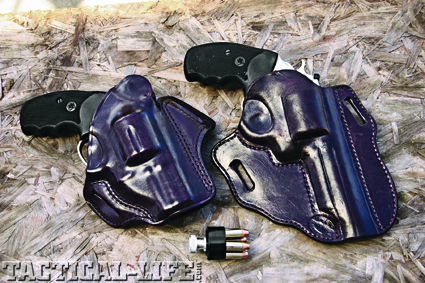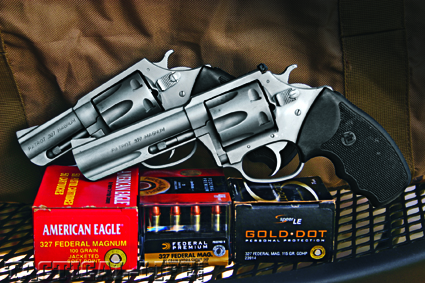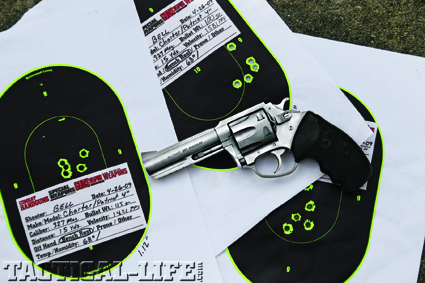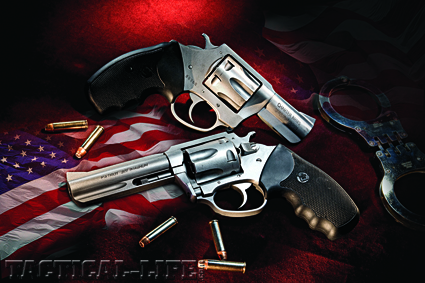In November 2007 Federal/ATK launched a new handgun cartridge, the .327 Federal Magnum with ammunition offered by American Eagle, Federal, and Speer, all of which are ATK brands. The .327 Mag is more of a true magnum than the older .32 H&R Mag that was introduced in 1983. This newer cartridge has much higher working pressures (up to 45,000 psi) and greater velocities, while the .32 H&R Mag factory loads were relatively mild, unless compared to the .32 S&W or .32 S&W Long. Initially the .327 Mag was chambered in the Ruger SP-101, but now some two years later this high-powered .32 is also chambered in revolvers from Smith & Wesson and Charter Arms.
Charter Arms has been producing handguns since 1964, which still makes it one of the newer US gun manufacturers that originated in New England. Their first product, the .38 Special “Undercover” 5-shot revolver was the lightest all-steel snubby (16 ounces) that could be had at the time. Later, the Charter .44 Special “Bulldog” was one of the first modern large-bore, factory-made concealment revolvers.
Gun Details
The Patriot revolver from Charter Arms was first offered with a 2.2-inch barrel. Based on the Bulldog frame, this stainless steel six-shooter is primarily intended as a concealment gun. Its compact size is complimented by a weight of just 21 ounces, which is due in part to the alloy grip frame/triggerguard unit. As this is a medium frame wheelgun, the full-size rubber, finger-groove grips do not look or feel out of place, and with the right holster do not compromise concealability. They are fully checkered to give a good, secure hold. As with most concealment-type revolvers, the 2.2-inch Patriot has a fixed rear sight and a sloping ramp front sight. The rear sight is square and wide. The front sight is 0.15 of an inch per my dial calipers, but the rear of the sight is smooth and hard to see in overhead light. It really needs to be serrated.
Advertisement — Continue Reading Below
The Patriot is your basic swing-out-cylinder, DA/SA revolver. The cylinder rotates to the right and there is an exposed hammer with a well-serrated spur. Its trigger is of medium width and smooth faced. The DA pull weight is probably in the neighborhood of 13 to 15 pounds, but the SA is crisp and about 5 pounds. Opening the cylinder is accomplished by pushing forward on the cylinder release latch. My 2.2-inch Patriot had a heavy barrel with a full-length rib on top and an ejector rod housing on the bottom. Finish on this revolver is a non-reflective matte and the alloy grip frame/triggerguard unit is anodized to match the frame. Overall quality is more than acceptable as far as metal-to-metal fit is concerned, and corners and curves were sharp, with no visible tool marks.
I also had Charter Arms’ 4-inch version called the Target Patriot. As you might suspect from the name, this revolver has a click-adjustable rear sight, which is black in color. Just about everything mentioned about the 2.2-inch Patriot applies to the 4-inch Patriot. Besides the different rear sight, the longer heavy barrel on this model also sports a full-length rib atop, and at the bottom, a full-length ejector rod housing. However, the housing on the 4-inch gun is fluted on both sides in the front. It weighs in at 23 ounces, only two ounces heavier than its smaller sibling, which should make it just about as handy to pack around. Again, holster choice will make a big difference.
Both guns also come in a nice black plastic pistol case with a foam-padded interior. You get the ubiquitous trigger lock, owner’s manual and with the Patriot a dividend…for the time being each revolver comes with a Kershaw Speed-Safe lock-blade pocketknife. It has a clip on the side for convenient carry, is gray with a black blade and marked on the left side “Charter .327.”
Advertisement — Continue Reading Below

Holsters & Loaders
I found a couple of holsters that conceal the Patriots nicely. For the 2.2-inch Patriot I selected an Alessi belt-slide type holster. It is all top-grain leather with lock-stitch stitching, and has two belt slots at the front and rear. There is no retention device, but the holster is molded to the gun for enhanced security. Two ears at the open top of the holster assist the user in getting the gun back into the rig using only one hand. My holster came in a beautiful oxblood color and was expertly finished.
For the 4-inch Patriot I used a pancake-style holster from Wild Bill’s Concealment. It is called the NBS (No Bull Scabbard) and looks like a traditional pancake design with extra leather on the front and back end to help blend the holster with the body. Wild Bill’s holsters are made of bullhide, which is advertised as being stronger and stiffer than cowhide. The holster was dyed an oxblood color, but the finish was showing some signs of flaking off.
I had the good fortune to have some HKS speedloaders on hand and found that the Model 32-J worked just fine to recharge the Patriot revolvers with fresh ammunition. HKS has been around for a long time and I used them extensively when I was a police officer and Deputy Sheriff back in the 1970’s and 1980’s. Besides duty use I also loaded with them when shooting PPC competition. For those who were still in diapers when these gadgets came out, they were spawned by police survival movement, which seemed to come on the heels of such deadly incidents as the Newhall shooting. On April 5, 1970 four California Highway Patrolmen were gunned down by a couple of bad guys. One officer who was shot was still trying to reload his revolver with loose rounds he carried in what we called a “dump pouch.” Use of speedloaders allows you to reload a revolver almost as fast as a semi-automatic pistol, depending on how much you practice with them.
Advertisement — Continue Reading Below

Velocity
I had cartridges from American Eagle, Federal and Speer. The American Eagle offers value priced ammunition and is an offshoot of Federal. Its .327 Mag load carries a 100-grain jacketed soft point bullet that has a flat tip where the lead core is exposed. I think the intent of this cartridge is good penetration and it might work well on varmints and up to medium-sized game animals. It is also cheaper than the hollow points and would make fine practice ammo, plus it comes in a 50-round box.
Federal produces the .327 Mag in their Premium Personal Defense line. The cartridge container also specified that this is a low recoil load. It has an 85-grain jacketed hollow point Hydra-Shok bullet; there is a small post swaged into the hollow nose cavity that promotes expansion. Speer added the .327 Mag to its Law Enforcement and Personal Protection line. Their cartridge has a 115-grain Gold Dot JHP, which has a special hollow point in the nose that is swaged into the bullet. Part of the jacket goes down into the cavity, and that is where the Gold Dot name originated. The process also produces jacket serration in the bullet nose that aids in expansion. Both the Federal and Speer loads have nickel-plated cases, while the American Eagle is just plain brass.
I made up some 10% ballistic gelatin to see what kind of expansion and penetration I would get from the three different .327 Mag loads I was using in my test. The gelatin blocks were shot from a distance of 10 feet on a fairly mild day with temperatures in the low 70’s. As expected the American Eagle cartridge with its JSP bullet went right through the gelatin block and into the dirt backstop of the range I was using. Expansion must have been almost nil as there was not much more than an oversize tunnel produced by the bullet going through the gelatin. The 85-grain Federal Hydra-Shok was the exact opposite; the lightweight bullet literally exploded the gelatin making a huge entrance cavity and penetrating to about 10 inches. Speer’s 115-grain Gold Dot also had very impressive performance and produced a big wound channel inside the gelatin. The bullet was recovered at the 13-inch mark. I used the 4-inch Patriot for this test and used both revolvers in the subsequent chronographing session to check velocity.
Advertisement — Continue Reading Below
Now I was really taken back when I fired my test ammunition through the 2.2-inch and 4-inch Charter Patriot revolvers. I was using my tried and true Oehler Model 35P chronograph, so I had no reason to doubt the figures it gave me. I was astounded with the velocities obtained from the 4-inch Patriot. The American Eagle cartridge with its 100-grain bullet zipped out of the barrel at an amazing average velocity of 1581 fps (feet per second) and velocities with the Federal and Speer loads ran from 1414 fps to 1519 fps. The rounds had a rather sharp “crack” when they went off, but recoil was easily handled and the only pressure signs were flattened primers. This would be an excellent self-defense caliber for those who are recoil sensitive.

Accuracy
It was now time for the “paperwork.” I set up my targets at a distance of 15 yards and fired 5-shot groups, SA from an impromptu bench rest consisting of a wooden folding tray table and topped with a sandbag. The American Eagle ammo had a best group that measured 1.72 inches with the 4-inch revolver and 2.73 inches with the 2.2-inch model. Using both guns with the Federal Hydra-Shok, I had a small group from the 4-inch gun, which my dial calipers said was 2.03 inches, and the best group from the 2.2-inch with this cartridge was 2.08 inches. Speer Gold Dots gave me a 1.12-inch group for the 4-incher and the 2.2-inch barrel gun provided a best group of 1.49 inches.
One thing I noted was the 2.2-inch Patriot tended to shoot low, especially with the 85-grain Federal bullet, so I aimed at the top of the Birchwood Casey Shoot-N-C bulls-eye target rather than in the center. The 4-inch version wanted to shoot a little to the right of the aiming point, but that’s what adjustable sights are for.
Advertisement — Continue Reading Below
To see what the Charter Arms Patriot revolvers would do in the practical shooting mode, I strapped on holsters and speedloader pouches to run the sixguns through a 30-round combat qualification course. During the course shooting is done from 3, 7, and 15 yards with single-hand use only at 3 yards, double- and triple-tap exercises at 7 yards, and barricade shooting at 15 yards both standing and kneeling. I decided to use the American Eagle load for this evaluation as I happened to have more of it, plus it performed well in both guns.
Starting out with the 2.2-inch Patriot, I moved up to the 3-yard line and got in the field interview stance. When the buzzer on my timer went off I drew and fired 6 shots with my right hand only. When I had emptied it, reloaded and fired 6 more with the left hand only. Shooting was done looking over the top of the revolver without using the sights. After reloading, I moved back to the 7 yard line and this time I was able to draw and fire using both hands and my sights—doing a series of three double-taps. Again at 7 yards I shot the body armor drill with two shoots to the body and one to the head. Then back to the 15-yard barricade where two shots are fired from the right side, two from the left side and two kneeling. This same process was repeated with the 4-inch Patriot.
Final Notes
Everything worked well, from the guns, to the holsters to the speedloaders. With the low recoil of the .327 Mag I was able to fire fast repeat shots and the hand-filling rubber grips also added much to the control quotient. I did find a few items to gripe about. First, the ejector rods came loose after extensive shooting, so that needs to be watched. Or, maybe just apply a little dab of Loc-Tite. The 2.2-inch gun when fired center-mass put all but one shot below the X-ring of the Birchwood Casey B-27 target, which means you may have to do some filing on the sights to get your gun regulated. I experienced quite a bit of difficulty with the Wild Bill’s holster when I tried re-holstering the handgun with one hand and without looking down at it. The “ears” at the top of the holster are too floppy and might need to have a metal or leather reinforcement to keep the holster mouth open. Overall, I was impressed with the Charter Arms Patriot revolvers and I was really impressed with the .327 Mag, I hope it catches on.
Advertisement — Continue Reading Below
























